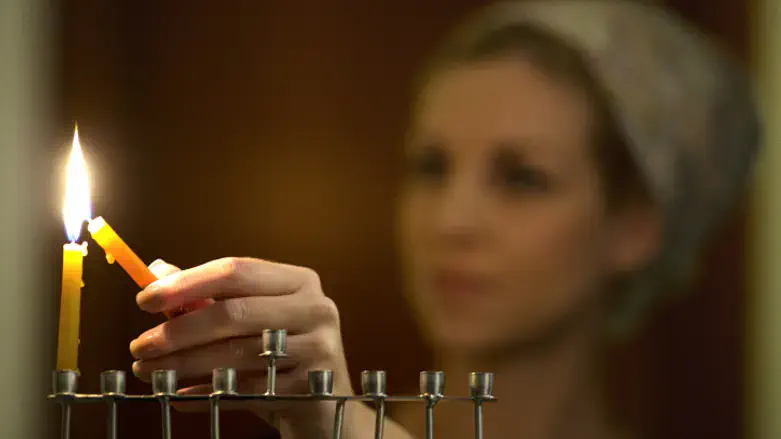
The Talmud (Shabbat 21b) records the different opinions of the Academy of Shammai and the Academy of Hillel regarding lighting the lights:
According to Beit Shammai we light eight candles on the first night, seven on the second night, six on the third, and so on, decreasing by one each day until lighting one candle on the eighth and final night.
According to Beit Hillel we light one candle on the first night, two on the second night, three on the third, and so on, increasing by one each day until lighting eight candles on the eighth and final night.
The Talmud continues by quoting the sage Ulla, who cited two explanations for this difference, two explanations given by two Amoraim, both of whom lived in the Land of Israel.
The first Amora was Rabbi Yossi bar Avin:
According to his explanation, Shammai saw the candles as corresponding to the days still to come, hence eight candles on the first night, seven on the second night, and so on until one candle on the eighth and final night when there is only one day left.
Hillel, by contrast, saw the candles as corresponding to the days which had already come, hence one candle on the first night, two on the second, and so on until eight candles on the eighth and final night.
The second Amora was Rabbi Yossi bar Zavda (or Zavida), who offered an alternative explanation for Hillel and Shammai’s difference of opinion:
According to him, Shammai saw the candles as paralleling the bulls which were sacrificed on Sukkot, which diminished from thirteen bulls on the first day of Sukkot, to twelve on the second day, and so on down to seven bulls on the seventh and final day of Sukkot (Numbers 29:12-34).
Hillel, by contrast, applied the principle that מַעֲלִין בַּקֹּדֶשׁ וְאֵין מוֹרִידִין, “we increase sanctity, and we do not decrease it”.
Rabbi Yossi bar Avin and Rabbi Yossi bar Zavda were friends and colleagues (Berachot 22a), living about three-and-a-half centuries after Hillel and Shammai.
And both were disciples of Rabbi Avahu in Caesarea (Yerushalmi Berachot 5:1), who in turn had been a disciple of Rabbi Yochanan ben Nafcha in Tiberias (Ketuvot 57a), who was a disciple of Rabbi Yannai (Bava Batra 154b), who was a disciple of Rabbi Yehudah ha-Nasi (Bava Batra 84b), who was son and disciple of Rabban Shimon ben Gamliel, who was son and disciple of Rabban Gamliel, who was son and disciple of Rabban Shimon, who was son and disciple of Rabban Gamliel the Elder, who was son and disciple of Rabban Shimon, who was son and disciple of Hillel – the same Hillel who opined that on the first day we light one candle, and from then on increase by one each day.
According to Rabbi Yossi bar Avin, Shammai emphasizes the potential (the days still left to come in the future), while Hillel emphasizes the actual (which night of this is).
This is consistent with Hillel’s and Shammai’s opinions throughout the Talmud: Hillel’s interpretations of Halachah always reflect the actual, Shammai’s always reflect the potential.
Hillel sees the world as it is, Shammai sees the world as it should ideally be.
In this, as in almost all disputes between Hillel and Shammai, we follow Hillel’s opinion. (There are just nine exceptions in the entire Talmud – six cases in which we follow neither opinion, and three in which we follow Shammai’s opinion.)
The Talmud (Eiruvin 13b) records that “for three years the Academy of Shammai and the Academy of Hillel disputed, each one claiming that ‘the halakhah follows us!’. A Heavenly Voice came forth, proclaiming: Both are the words of the Living G-d – and the halakhah follows the Academy of Hillel”.
The Yerushalmi (Berachot 1:4, Yevamot 1:6, Sotah 3:4, and Kiddushin 1:1) cites the same episode in several places, and provides an additional detail: “Where did this Heavenly Voice come forth? – …In Yavneh”.
“In Yavneh” – meaning after the destruction of the Holy Temple, after the Sanhedrin had relocated to Yavneh from the Chamber of Hewn Stone at the entrance of the Holy Temple.
And when will Beit Shammai’s opinion constitute practical halakhah? – The Zohar (Ra’ayah Meheimnah Volume 3, Parashat Pinchas 245) posits that Hillel’s opinion is appropriate for this world, while Shammai’s opinion is reserved for the days of Mashiach.
That is to say: in today’s imperfect world, we follow Hillel’s rulings. In the future time to come, when the world will be perfected, when today’s potential will become the actual, we will light eight candles on the first night of , seven on the second, and steadily diminish until we will light one candle on the eighth and final night.
And so this Wednesday afternoon, as in previous years, when I will prepare my Menorah for the first night of , I will fill eight vials of olive oil ready for lighting. Because I don’t know what might yet happen in the few hours before nightfall. And I want to be ready for anything that may happen. And maybe, just maybe, before sunset…